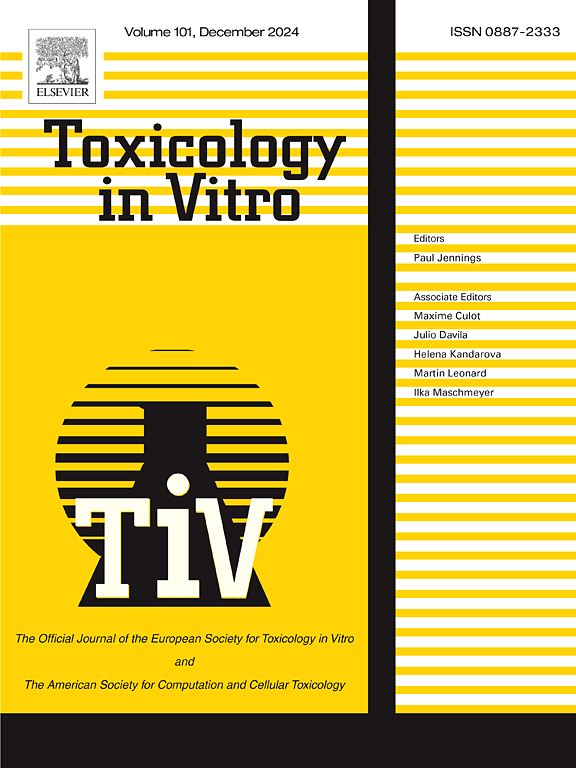多胺修饰的萘二甲酰亚胺衍生物 9C 通过 ROS 介导的 ER 应激、迁移和侵袭抑制结直肠癌。
IF 2.7
3区 医学
Q3 TOXICOLOGY
引用次数: 0
摘要
过去几十年来,越来越多的证据表明,针对癌症的内质网(ER)应激信号具有治疗潜力。萘二甲酰亚胺类化合物以多种方式发挥抗癌活性。然而,萘二甲酰亚胺类药物对ER应激的影响却鲜有报道。在本研究中,基于 RNA 序列分析,我们观察到萘二甲酰亚胺衍生物 9C 可引发 ER 应激,从而激活死亡受体信号转导和自噬。预处理ER应激抑制剂(如柳氮磺吡啶)和自噬抑制剂(如3-甲基腺嘌呤(3-MA))可部分逆转9C诱导的细胞生长抑制。此外,我们的研究结果还揭示了活性氧(ROS)依赖性的 9C 抑制作用。此外,9C 还能抑制结直肠癌细胞的迁移和侵袭。使用 N-乙酰-L-半胱氨酸(NAC)清除 ROS 可减轻 ATF4、CHOP、死亡受体、E-cadherin 以及凋亡和自噬相关蛋白的表达。综上所述,我们的研究结果表明,ROS介导的ER应激、迁移和侵袭是包括9C在内的萘二甲酰亚胺类药物对CRC具有治疗潜力的原因。本文章由计算机程序翻译,如有差异,请以英文原文为准。
Polyamine-modified naphthalimide derivative 9C inhibits colorectal cancer through ROS-mediated ER stress, migration and invasion
Mounting evidence over the past decades has demonstrated the therapeutic potential of targeting endoplasmic reticulum (ER) stress signaling in cancer. Naphthalimdes exert their anti-cancer activities in a variety of ways. However, the effects of naphthalimides on ER stress are rarely reported. In this study, based on RNA-sequencing analysis, we observed that 9C, a naphthalimide derivative, could trigger ER stress to activate death receptor signaling and autophagy. Pretreatment of ER stress inhibitor, such as salubrinal, and autophagy inhibitor, such as 3-methyladenine (3-MA), partially reversed 9C-induced inhibition of cell growth. Furthermore, our results unveiled a reactive oxygen species (ROS)-dependent inhibitory effect of 9C. In addition, 9C inhibited colorectal cancer (CRC) cells migration and invasion. Removal of ROS using N-acetyl-L-cysteine (NAC) attenuated the expression of ATF4, CHOP, death receptors, E-cadherin, and the apoptosis and autophagy related proteins. Taken together, our results suggested that ROS-mediated ER stress, migration, and invasion is responsible for the therapeutic potential of naphthalimides including 9C in CRC.
求助全文
通过发布文献求助,成功后即可免费获取论文全文。
去求助
来源期刊

Toxicology in Vitro
医学-毒理学
CiteScore
6.50
自引率
3.10%
发文量
181
审稿时长
65 days
期刊介绍:
Toxicology in Vitro publishes original research papers and reviews on the application and use of in vitro systems for assessing or predicting the toxic effects of chemicals and elucidating their mechanisms of action. These in vitro techniques include utilizing cell or tissue cultures, isolated cells, tissue slices, subcellular fractions, transgenic cell cultures, and cells from transgenic organisms, as well as in silico modelling. The Journal will focus on investigations that involve the development and validation of new in vitro methods, e.g. for prediction of toxic effects based on traditional and in silico modelling; on the use of methods in high-throughput toxicology and pharmacology; elucidation of mechanisms of toxic action; the application of genomics, transcriptomics and proteomics in toxicology, as well as on comparative studies that characterise the relationship between in vitro and in vivo findings. The Journal strongly encourages the submission of manuscripts that focus on the development of in vitro methods, their practical applications and regulatory use (e.g. in the areas of food components cosmetics, pharmaceuticals, pesticides, and industrial chemicals). Toxicology in Vitro discourages papers that record reporting on toxicological effects from materials, such as plant extracts or herbal medicines, that have not been chemically characterized.
 求助内容:
求助内容: 应助结果提醒方式:
应助结果提醒方式:


